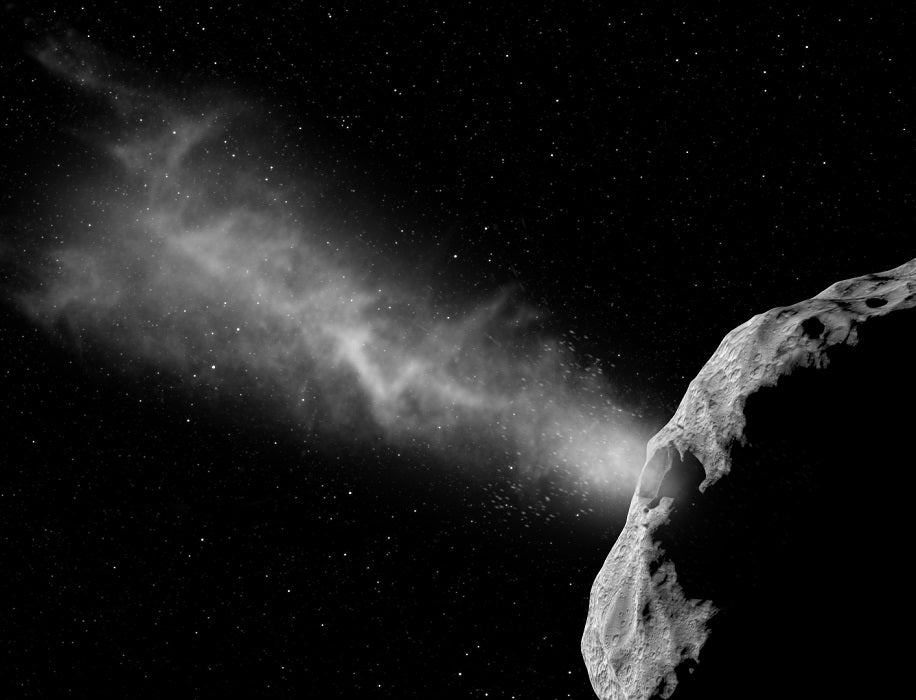
In this conceptual image, a plume of smoke rises from Dimorphos as the DART mission impacts the asteroid's moon. These kinetic impacts are one way an asteroid could be deflected, but a new study suggests that nuclear bombs could also be effective. Credit: ESA
Deflecting killer asteroids with nuclear weapons has long been the stuff of science fiction. But thanks to an experiment at Sandia National Laboratories, that scenario is one step closer to becoming a reality.
Led by physicist Nathan Moore, Sandia researchers in Albuquerque, New Mexico, used a powerful beam of X-rays to blast away tiny fragments of quartz and silica, just as they hope future equipment might be able to divert an asteroid from a collision course with Earth.
The X-rays blasted the surface of the chips, releasing a cloud of vapor that hurled them away from the laser at 260 km/h (160 mph). Computer models suggest this should work at much larger scales than what they tested in the lab. While the experiment used chunks of material just half an inch (1.2 cm) in diameter, Moore's team says their calculations show the basic idea is powerful enough to successfully deflect asteroids up to 4.4 km (2.7 miles) in diameter, making their research, published today in Physics of naturea significant step toward practical planetary defense.
Nuclear defense
The solar system is littered with rocky space debris, left over from its formation or created by eons of collisions. Chance gravitational encounters can send these asteroids hurtling out of the solar system or heading for an unsuspecting planet. One of those objectsThe asteroid, about 10 to 15 kilometres wide, probably slammed into Earth 66 million years ago, wiping out the dinosaurs. The question is not whether another big impact will happen, but when.
The effort to prevent such a disaster is called planetary defense and takes many forms. NASA is responsible for leading the detection and tracking of potential impacts. The agency also sent the DART (Double Asteroid Redirection Test) mission to asteroid 65803 Didymos and its tiny moon Dimorphos, to see if launching a projectile at a space rock could deflect it.He did it.)
But larger asteroids might require multiple impacts, each of which would move the asteroid to some extent. In that case, an energy-based deflector system starts to look attractive.
Enter nuclear weapons.
Yes, just like in the movie. ArmageddonScientists believe nuclear weapons could also be tools to protect Earth from approaching asteroids. However, detonating a nuclear weapon directly on an asteroid could risk fracturing it rather than significantly deflecting it, causing many smaller, but equally deadly, meteorites to rain down on Earth.
One of the leading proposals is to detonate a nuclear bomb at some distance from the asteroid. Such an explosion is more likely to deflect the asteroid than destroy it.
But since deploying nuclear weapons in space is a violation of the 1967 Outer Space Treaty — and should not be taken lightly — this theory may be difficult to test.
Asteroid jetpack
Moore and his colleagues turned to Sandia's Z Pulsed Power Facility, a powerful pulsed power machine capable of creating conditions as extreme as a large nuclear explosion, albeit on a much smaller scale.
The Z machine, as it is informally called, is the world’s largest pulsed-energy machine. It fires electrical pulses 1,000 times stronger than lightning, delivering up to 22 megajoules of X-ray energy to test objects. This amount of energy is minuscule in the world of nuclear detonations, but more than enough to practice on miniature asteroids. Moore’s experiment used two chips: one made of quartz and one made of fused silica, the latter a common component in asteroids.
The X-rays imparted some momentum to the chips, but most of the thrust came from a different mechanism: The X-rays heated the surface of the material, causing it to vaporize. The material then expanded away from the surface, like a rocket or jetpack, pushing the chip in the opposite direction. Scientists observed the same effect. When the DART mission crashed into Didymos, the ejected material propelled the asteroid farther than the impact spacecraft.
Moore says laboratory experiments are important to understand how an asteroid might react to a real attempt to deflect it. Asteroids are notoriously misshapen and strange clumps of material, which are difficult to model accurately with computers. Performing an experiment with increasingly complex samples becomes the easiest option.
Although the current experiment is a proof of concept with simple chips, he and his colleagues plan to test more realistic and complicated mixtures of iron and nickel. “That’s why it’s so important to do this experiment,” he says.
For now, NASA says our skies are clear. Let's hope they stay that way until Moore, NASA and other groups bring us a little closer to the answer to how to steer an asteroid.